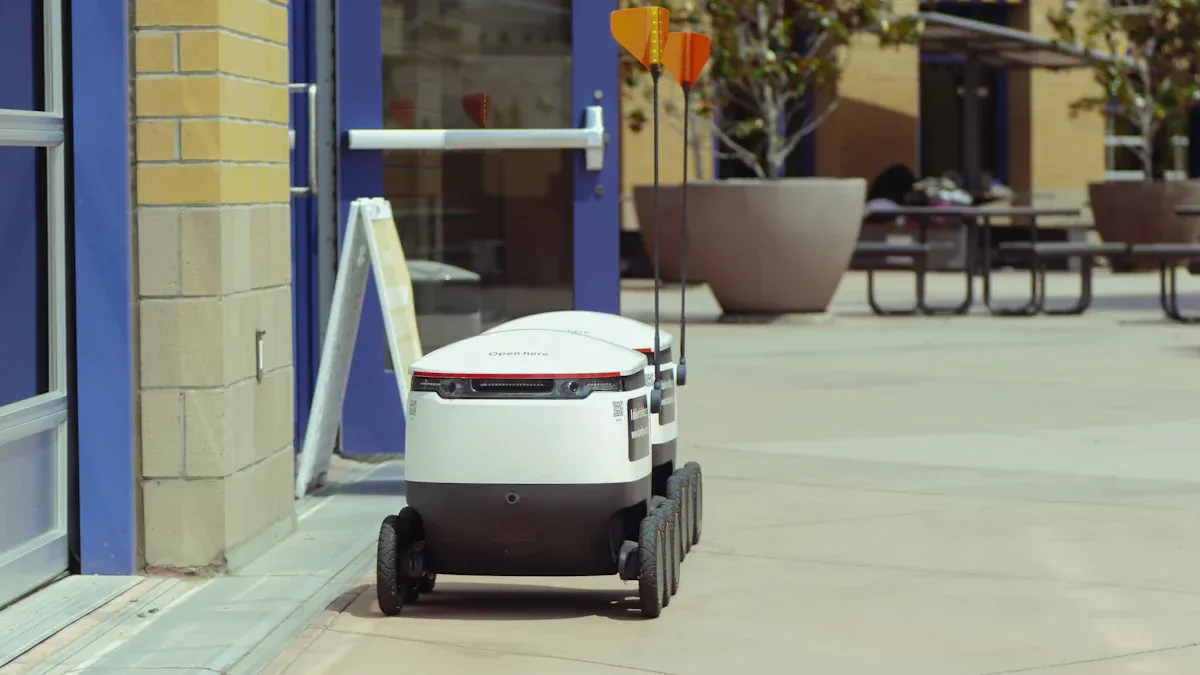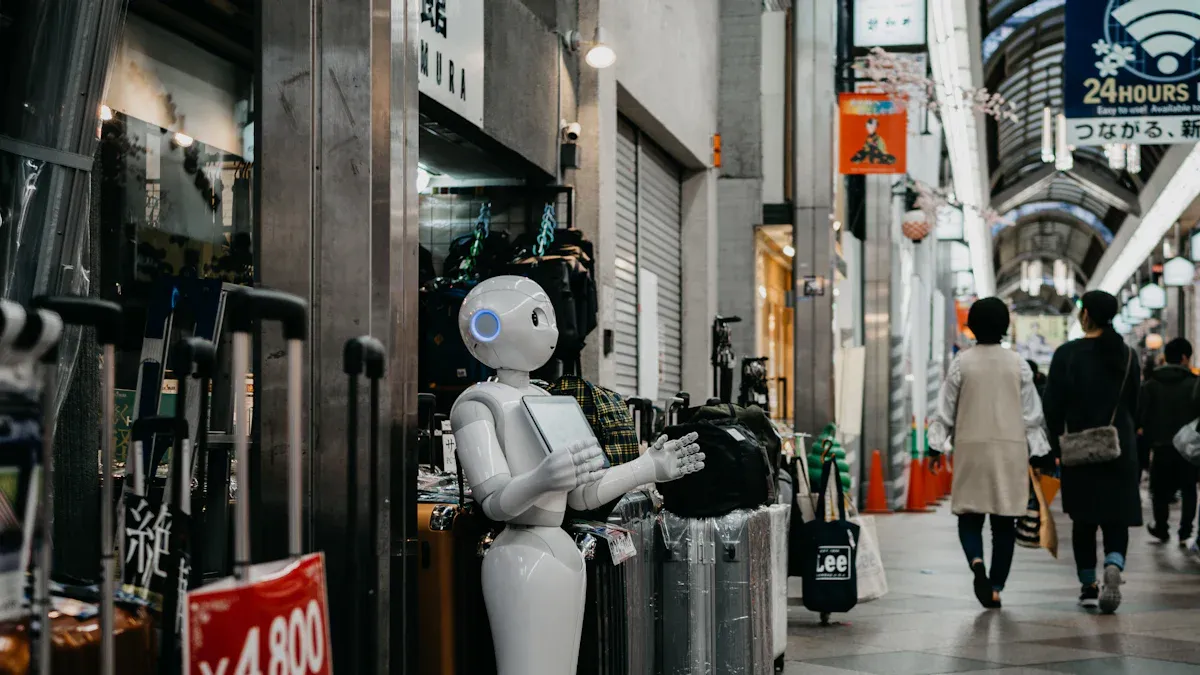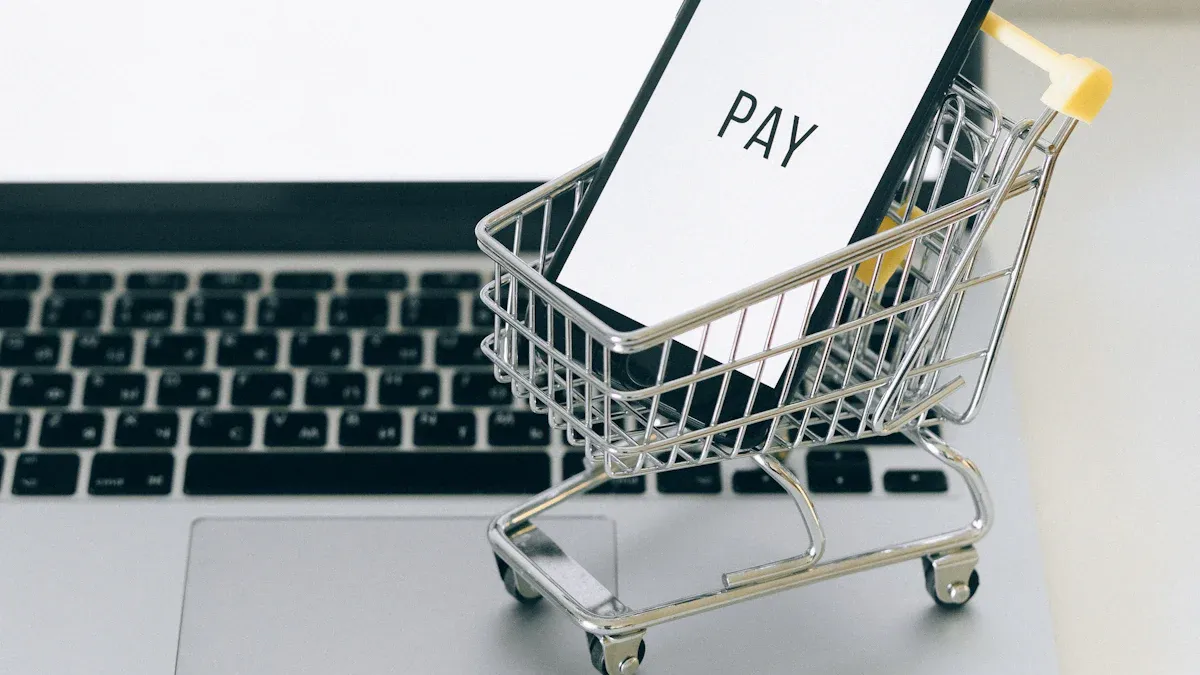Are Autonomous Checkout Robot Carts the Next Big Thing in Retail

You now see autonomous checkout robot carts rolling through stores. These smart carts use AI to change how you shop. The market for these robots is growing fast:
The global market value could reach USD 1.21 billion in 2024.
Growth may continue at 18.4% each year until 2033.
By 2033, the market could reach USD 5.72 billion.
Key Takeaways
Autonomous checkout robot carts help you shop faster and easier. You can see how much you spend as you shop. This helps you stay within your budget.
These smart carts use technology like AI and RFID to track items. They also give you special deals just for you. This makes shopping better for you.
Stores save money by using these carts. They can also keep better track of their products. This means customers get better service.
Autonomous Checkout Robot in Stores

Technology Overview
You can now find smart shopping carts in many stores. These carts use new technology to help you shop faster and easier. Each autonomous checkout robot has computer vision, RFID technology, and mobile payment systems. Computer vision lets the cart see what you put inside. RFID tags keep track of items without scanning barcodes. Mobile payment systems let you pay right at the cart, so checkout is fast.
Here is a table showing the main technology parts:
Technology Component | Description |
|---|---|
Computer Vision | Uses cameras and AI to watch what you pick up or put back. |
RFID Technology | Follows products with RFID tags, so you do not scan each one. |
Mobile Payment Systems | Lets you pay with apps, digital wallets, or NFC for easy payment. |
Smart shopping carts also use artificial intelligence and machine learning. These tools help the cart learn what you like to buy. The cart can suggest things you might want. Automated checkout, product tracking, and smart shelves work together to make shopping smooth. Data analytics and cloud computing help stores keep track of items and make your trip better. Digital screens on the cart show your total and give you deals while you shop.
You can see different kinds of automated carts in stores now. Some popular ones are Caper, Servi, and A401-A402. Caper’s screen shows what you buy and any discounts. A401-A402 can scan barcodes, let you check out yourself, and even weigh your fruit. Both types of carts help you shop faster and make things easier.
How It Works
When you walk into a store, you take a smart shopping cart. The cart says hello on its screen. You can scan your loyalty card or use a QR code to connect your shopping list app. The cart uses GPS to help you find what you need. As you put things in, the cart’s cameras and sensors notice and record each item. You can see how much you are spending on the screen.
The cart’s AI gives you special offers and coupons based on what you buy. If you need help, the cart can tell you where to find things. When you are done, you pay right at the cart using its payment terminal. You do not have to wait in line at checkout.
Stores use these carts to connect with their inventory systems. Companies like Brain Corp, Simbe Robotics, and Bossa Nova Robotics make tech that helps carts scan shelves and check stock. This helps stores know when to restock. Caper Labs works to make shopping better with their autonomous checkout robot. These systems also help with online grocery orders by tracking what is in stock.
Here are some features you might find in top smart shopping carts:
Real-time spending updates on the cart’s screen
Personalized offers and product suggestions
GPS to help you find things
Connects with shopping list apps
Self-checkout on the cart for quick payment
Semi-autonomous carts and robotic serving carts help stores too. They can bring items to customers or help restock shelves. More stores are using automation, and these carts are leading the change. You get a faster, more personal shopping trip. Stores get better data and can control their inventory. Automated, ai-powered robotic carts are changing how you shop and how stores work.
Shopping Experience
For Shoppers
When you use autonomous checkout robot carts, shopping feels different. These smart carts help you shop faster and make things easier. You do not have to get any apps or sign up before shopping. The cart keeps track of what you put in. It shows your total right away, so you know how much you spend. This helps you stick to your budget and makes self-checkout easy. You get a receipt as soon as you finish shopping, which makes you happy.
Here are ways these carts make shopping better for you and other customers:
Feature or Benefit | How It Improves Your Shopping Experience |
|---|---|
No app needed | You save time and do not need extra steps |
No waiting in line | Shopping is quicker and easier |
Real-time totals | You can watch your spending |
Instant receipts | You get proof of what you bought |
AR product info | You see more details and deals while shopping |
You feel good in stores that use this new technology. The store looks modern and friendly. Many people come back because they trust the carts and like the better shopping experience.
For Retailers
If you own a store, automation changes how you work every day. Autonomous carts do many jobs, so workers can help shoppers more. This makes things better for both workers and customers. There are fewer mistakes with stock and shelves get filled faster.
Impact Area | Description |
|---|---|
Staff can help shoppers instead of doing the same jobs over and over | |
Inventory Accuracy | Robots check stock fast and make fewer mistakes |
Store Maintenance | Cleaning robots help keep the store neat and safe |
Data Collection | Stores get real-time info to know what people want and keep shelves full |
Stores also spend less money. AI-powered automation can lower worker costs by up to 70%. Checkout is 30-40% faster, so stores save up to 20% on running costs. These savings let stores give better service and make shopping nicer for everyone.
Cashierless Checkout Benefits

Speed and Efficiency
Most people want to shop fast. Cashierless checkout helps you do this. You pay at the smart cart, not at a register. There is no line to wait in. This saves time and makes shopping easier. Many people say cashierless systems make shopping smoother. You can see how much you spend as you go. This helps you feel in control.
Smart carts let you pay right away.
You do not have to stand in line.
Cashierless shopping is quicker and easier.
You get your receipt right after paying.
Stores also get big benefits. Cashierless systems can make checkout 25–40% faster. They help stores spend less on workers, up to 30% less. The carts give stores real-time data to help with inventory. Stores can make quick choices with this data. The table below shows how cashierless tech helps stores work better:
Mechanism | Impact on Store Efficiency |
|---|---|
Real-time data processing | Helps stores make choices and track inventory |
Accurate product identification | Makes fewer mistakes with items |
Improved customer experience | Makes checkout faster and lines shorter |
Personalization
Cashierless checkout does more than save time. It makes shopping feel special for you. The cart can know who you are and say hello. It remembers what you bought before. The cart can suggest new things you might like. This helps you find what you want faster.
The cart greets you by name when you start.
It keeps track of what you buy and gives tips.
You see deals and offers that fit your likes.
Many companies use AI to make these features better. Hilton Honors and Starbucks Rewards use AI to suggest rewards you may want. Amazon Prime and Sephora use AI to help you shop more. Studies show AI suggestions can boost online sales by up to 25%. Stores using AI see 40% more customers come back. You get a shopping trip that fits you, and stores keep their customers happy.
Real-World Examples
Leading Brands
You can find autonomous checkout robot carts in many big stores. Schnucks uses Caper carts to help shoppers move fast. Jewel-Osco has Servi carts that guide you and carry groceries. Migros, a big store in Europe, uses Taro carts for families. SpartanNash and Mashgin also use smart carts in their stores. These carts help you find things and keep track of spending. You finish shopping faster with these carts. Supermarkets use them to make self-checkout better and cut down waiting. More stores now have carts with screens and smart sensors.
Customer Feedback
Many shoppers say these carts make shopping easier. You and your family get help from the carts:
Shopping is quicker and easier.
The carts give you personal help.
You do not wait in long lines.
Families like the extra help.
Stores see big changes after using these carts. Here is a table that shows what gets better and what is hard:
Improvements | Challenges |
|---|---|
Shorter waiting times | Privacy concerns |
Reduced staffing requirements | High initial costs |
Enhanced data collection |
These carts help stores work better and make shopping easy. Stores use cart data to keep shelves full and give better service. You get a faster and smoother checkout every time you shop.
Challenges
Technical Issues
Autonomous checkout robot carts can cause new problems for stores. These smart carts must spot many products and work fast. They also need to connect with store systems. Sometimes, the carts mix up items that look alike. Store lights can change, making it hard for carts to see things. The AI has to learn how people shop, which is not simple.
Here is a table with some common technical problems:
Technical Issue | Description |
|---|---|
Product Recognition | Hard to tell apart products that look almost the same. |
Real-time Data Processing | Needs strong computers to keep up and work fast. |
System Integration | Must connect well with store inventory and management. |
Adaptability | Needs to handle changes in displays and lighting. |
Customer Behavior Analysis | Has trouble understanding all the ways people shop. |
Stores use wireless charging to keep carts ready to go. Smart software helps manage batteries and makes carts last longer. These steps help stores keep carts working well for self-checkout.
Privacy and Acceptance
You might wonder what information these carts collect about you. Some shoppers worry about their privacy. The carts can track what you pick up and almost buy. They also watch how you move around the store. This data helps stores give you deals, but it can also worry people.
Some people think data collection and ads may push expensive products and hide deals.
The carts can record your choices, even if you do not buy anything.
"Smarter shopping carts are not just for faster checkout. Tech companies use them to collect data on shoppers. They mix this with other data for their business. This ‘smart’ tech is really for watching people. It can hurt Americans’ privacy for money."
You may feel unsure about using these carts if you think your data is not safe. Stores need to show you that your privacy is important and earn your trust.
Future Outlook
Adoption Trends
You will see more stores testing autonomous checkout robot carts in the next few years. Some people love using new technology, but others feel unsure. Here are some things that help or slow down adoption:
Customer acceptance matters. Tech-savvy shoppers try smart carts first, but older people or those who do not use digital tools may wait.
Privacy concerns can stop people from using these carts. Shoppers want to know how stores use their data.
Operational costs can be high. Stores must pay for repairs and updates, which can be hard if the carts break down.
Retailers who address these issues will see more people using smart carts. You may notice more stores offering self-checkout options as they try to make shopping easier for everyone.
What’s Next
You can expect even smarter carts soon. New technology will change how you shop:
Computer vision will help carts recognize products and follow your path in the store.
Machine learning will let carts process data quickly, making checkout faster and more accurate.
Regulations will also shape the future. Agencies like the FTC and OSHA will set rules for data security and safety. Companies must follow these rules, which may raise costs and change how carts work. You will see more focus on privacy and safety as these carts become common. The next generation of smart carts will help you shop faster and safer, making your trips to the store better than ever.
More stores now have autonomous checkout robot carts because self-checkout is getting popular. Experts say these carts help you shop faster and track what you buy right away. They also give you service that fits your needs. But there are some problems, like the carts costing a lot and people not always trusting them. As AI gets better, shopping will feel easier and checkout will be even smoother.
FAQ
How do autonomous checkout robot carts know what you buy?
You place items in the cart. The cart uses cameras and sensors to recognize each product. You see your total on the screen before you finish checkout.
Do you need to download an app to use these carts?
You do not need to download an app. You can start shopping right away. The cart tracks your items and helps you with self-checkout.
Are these carts safe for your privacy?
You control your data. Stores use security steps to protect your information. You can ask how your data gets used before you shop.
See Also
The Future of Retail Lies in AI-Driven Stores
Upcoming Changes to Walmart Self-Checkout by 2025
Walgreens Self-Checkout: Benefits and Obstacles in Retail
